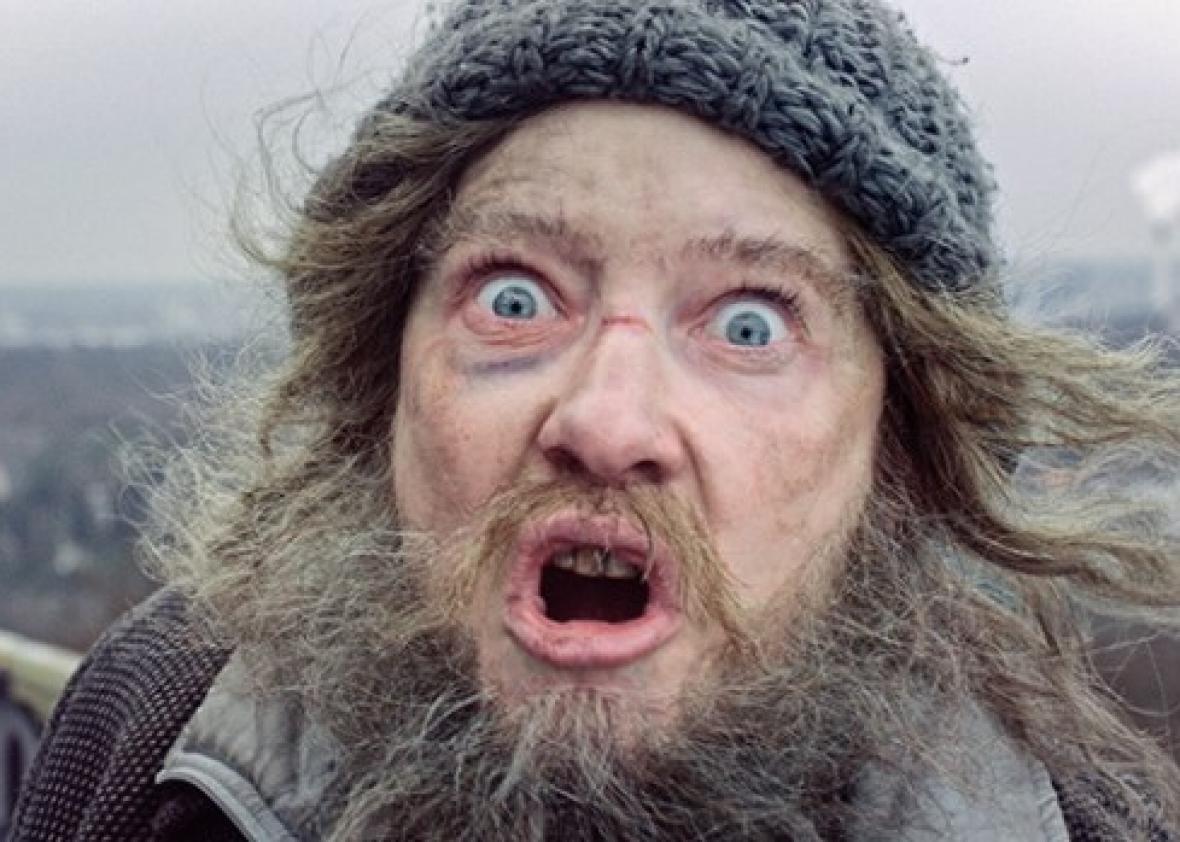“It’s … is it a film?” It’s a fair question Cate Blanchett asks. Manifesto is now playing at New York’s Film Forum, and it screened as part of the Tribeca and Sundance Film Festivals, and yet the tricky epistemological matter of what exactly it is remains. The work—that’s a nice neutral noun, right?—began as a multichannel video installation by the artist Julian Rosefeldt, with Blanchett playing a dozen different characters reading texts compiled from sources ranging from Marx and Engels to Lars von Trier. The “linear version,” as Blanchett and Rosefeldt call it, condenses those channels into one and further trims the installation’s collective two-plus hours of footage into a tidy 90-odd minutes. The result is neither fish nor fowl, no longer video art but not quite a coherent theatrical feature, even an abstract and non-narrative one.
One thing Manifesto, in any manifestation, is: a showcase for Blanchett’s prodigious talents. In the course of the movie (let’s just call it that), she plays a frumpy hausfrau; an imperious, Russian-accented choreographer; a shambling, raccoon-eyed punk singer; and a bearded homeless man. (The first list of potential characters numbered around 60.) Although Blanchett’s personae sometimes match up to the words she’s saying—a patiently tsk-tsking schoolteacher instructs grade-school children in the elements of von Trier’s abstemious Dogme 95 manifesto—the scenes weren’t conceived as dramatic set pieces, Rosefeldt explained alongside Blanchett at a New York hotel last week, nor was there necessarily an intellectual rationale for placing a given scene in a given setting. “An analyst might find a reason for it,” he said, “but that wasn’t really the recipe. The aim was always peeling out the original core of the idea and context.” His slice-and-dice approach to the original texts, with bits of a dozen or more combined into a single monologue, strips the manifestos of their intended prescriptive meaning, leaving a kind of urgent, all-purpose exhortation. “There’s a heavy, thick layer of dust, of interpretation, throughout history. If you blow this away, all of a sudden, you find a very fresh text that not necessarily connects to the visual work but therefore is beautiful to discover or rediscover as pure poetry and utopia.”
Although Manifesto’s characters were conceived without any psychological underpinnings, Blanchett didn’t find it especially difficult to grasp them through their actions, even though the entire project was captured in only nine days of shooting. “The thrust of the character was very much about what they did and what they said, rather than how they felt,” she said. “It was more about making a mask that could be taken on and off. It was much more interesting for us to elaborate them as part of a mosaic that creates society as a whole, like a puzzle.” Blanchett’s fitness for projects like Manifesto or Todd Haynes’ I’m Not There makes you wonder if she’s not an avant-garde actress who is only incidentally a movie star. Much more challenging, she says, was recording the movie’s voice-over, in which Rosefeldt’s bricolage monologues had to be spoken as a continuous whole. “I thought my eyeballs were gonna drop out, or my ears were gonna start bleeding,” she said. “When you’re not distracted by the visuals, you have to make sense of these things, which are often nonsensical. It was really hard to find a psychological attitude toward something that doesn’t have one.”
Perhaps the most charming of Manifesto’s segments is the one in which Blanchett plays a puppeteer who creates and then interacts with a puppet version of herself. The interplay between real Blanchett and puppet-Blanchett is so fluid that I wonder if she’d previously honed her skills on some past project. Blanchett chuckles. “What puppetry skills?” But Rosefeldt was equally impressed. “After you did that scene,” he says to Blanchett, “there were rumors in the crew, like when did you learn this?” He turns toward me and away from her playful “oh, you” scoff. “She says, ‘I think I learned it two minutes ago.’ ”
“I’d watch you,” Blanchett says to Rosefeldt. “You have an incredible facility. I often find with directors that if you turn the sound down on what a director says to you, there’s something about the way in which a director communicates; they’re giving you the direction in a physical sense. Or if you watch their eyes you think, ‘Oh, I think I understand what you mean.’ ”
It’s fitting that in a project devoted to stripping words from their original meaning that so much of the communication would be nonverbal. And in breaking apart the sometimes blustering rhetoric of its sources, Manifesto also finds room for a new voice. “When you see it in all in one piece, it seems like it’s from a group mind rather than an assertion of individual expressions, and I think you’re much more aware, as an end result, that you’ve got a whole lot of manifestos written by men,” Blanchett says. “But the female presence is also much stronger in the linear version. I think you make that connection a lot stronger. The female presence is more acute.”
